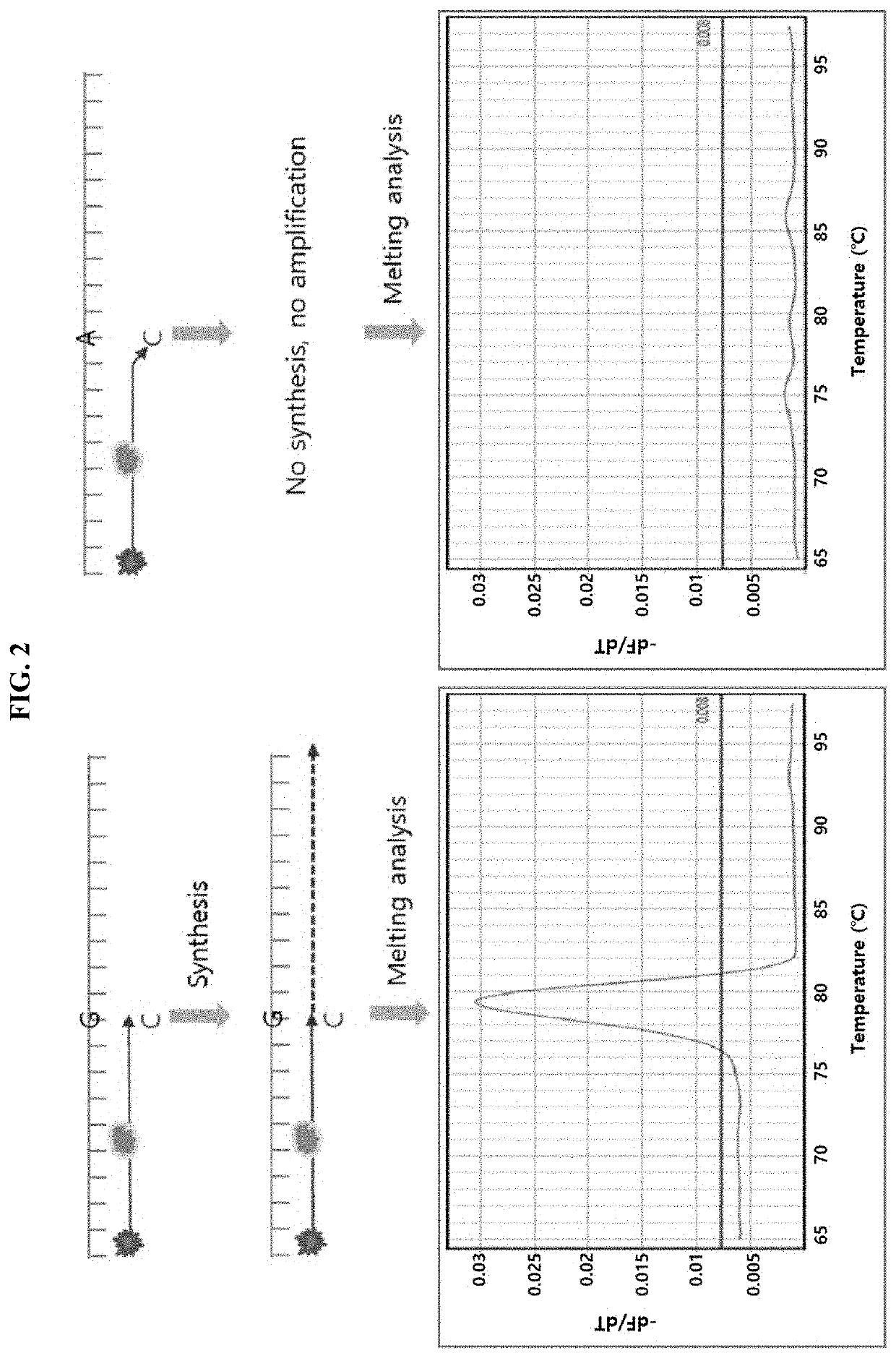Multiple analysis method for amplicon by using fluorescence-based multiple melting analysis
- Summary
- Abstract
- Description
- Claims
- Application Information
AI Technical Summary
Benefits of technology
Problems solved by technology
Method used
Image
Examples
example 2
Rice Variety Identification Using Allele-Specific FMMA
[0097]Allele-specific FMMA for 20 gene markers used for rice variety identification was designed, and identification tests for 4 rice varieties were performed. Four fluorescence channels (FAM, HEX, Texas Red, and Cy5) were used to enable analysis of 10 markers per test set, and the melting temperature was distributed to enable analysis of 2 or 3 markers for each fluorescence channel. Twenty genetic markers were analyzed using two sets capable of analyzing 10 genetic markers, respectively, and the results are shown in FIGS. 4 and 5.
[0098]As can be seen from the results in FIGS. 4 and 5, it was confirmed that the DNA extracted from the sample rice was specifically amplified in the marker set for rice variety identification, indicating that the sample rice was correctly identified to meet variety identification requirements. From this result, it was confirmed that multiple alleles can be analyzed in a single reaction by using two or...
example 3
Analysis of Melting Temperature Distribution Depending on Length of Nucleic Acid Amplification Product
[0100]In order to analyze multiple markers in a single fluorescence channel as in Example 1, it is necessary to distribute the melting temperature appropriately between the markers. In order to understand factors that influence the determination of the melting temperature, the correlation between the length of the amplification product and the melting temperature thereof was examined. The fluorescently labeled primer was fixed, and the length of the product was adjusted by changing the position of the reverse primer, and the melting temperature was analyzed. That is, as the 5′ end fluorescent primer, the same primer was used, and as the 3′ end primer, a primer having an adjusted length was used so that the length of the amplification product would vary between 50 bp and 350 bp. The primers used are shown in Table 3 below.
TABLE 3PCRPCR productproductTmNameNucleotide sequencesize (bp)...
example 4
Analysis of Melting Temperature Distribution on Length of Nucleic Acid Amplification Product and GC Content
[0102]Among factors that influence melting temperature, the correlation between the GC content of the melting temperature control sequence used and the melting temperature of the entire amplification product was analyzed.
[0103]For three rice variety genetic markers (BR12, BR16, and BR20), the positions of the 5′ and 3′ end primers on the target nucleic acid gene were fixed, and the GC content of the melting temperature control sequence of the 5′ end primer was set to two types (high and low GC %). The primers used are shown in Table 4 below. Under these conditions, analysis was performed, and the results are shown in FIG. 7.
TABLE 4GC% of TmMarkerPrimerNucleotide sequencecontrol sequenceBR12BRa12-[TexasRed]GCGGGCCGCGGGCGCCGCCAC[BHQ2]95.238F2_Hi(Texasred)TCGACGGCGACCTGACTTGT(SEQ ID NO: 38)BRa12-[TexasRed]GGAGACATCAGATACAGAGTG[BHQ2]47.619F2_Lo(Texasred)TCGACGGCGACCTGACTTGT(SEQ ID ...
PUM
| Property | Measurement | Unit |
|---|---|---|
| Melting point | aaaaa | aaaaa |
| Melting point | aaaaa | aaaaa |
| Melting point | aaaaa | aaaaa |
Abstract
Description
Claims
Application Information
 Login to View More
Login to View More - R&D
- Intellectual Property
- Life Sciences
- Materials
- Tech Scout
- Unparalleled Data Quality
- Higher Quality Content
- 60% Fewer Hallucinations
Browse by: Latest US Patents, China's latest patents, Technical Efficacy Thesaurus, Application Domain, Technology Topic, Popular Technical Reports.
© 2025 PatSnap. All rights reserved.Legal|Privacy policy|Modern Slavery Act Transparency Statement|Sitemap|About US| Contact US: help@patsnap.com



